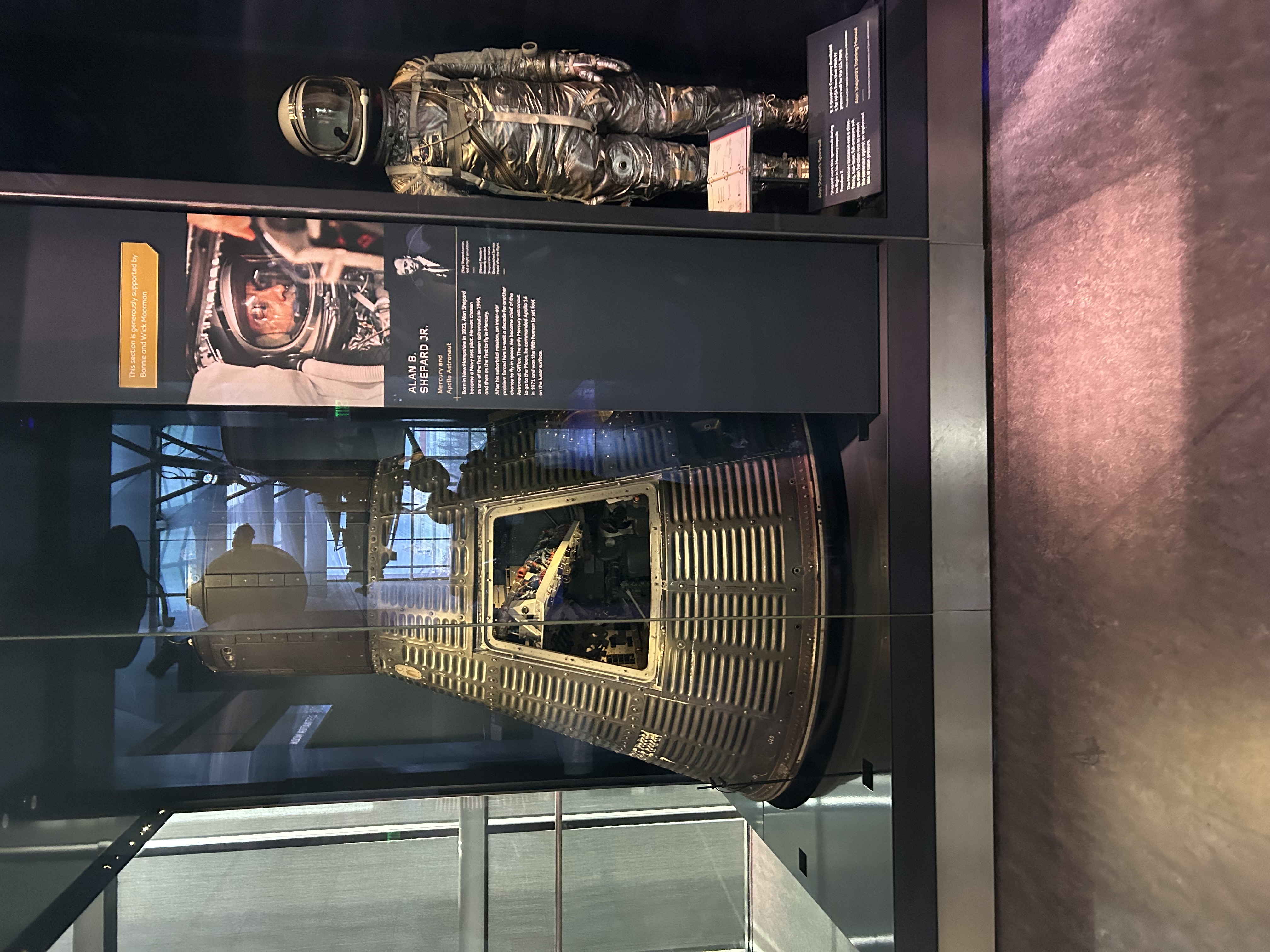Gallery: one World Connected What specific concepts, discoveries, or inventions are portrayed? Select three (3) such examples from EACH gallery. They talk about the importance of satellites and all they do to help support our world with sending information instantaneously across the globe. They also talk about the importance climate change has in our lives and how we need to cater to our planet because we are hurting it. They have a section where in giant letters above says “How will you shape the future?” and the section talks about areas where deforestation and plastic pollution reside.
How does the gallery convey information relevant to 2 above: give specific examples of specimens, drawings, texts, graphics, etc. They have a huge animated globe in the center of the room that shows connections made by airplanes and satellites all over the world. It is crazy to see how much happens at once in this world to keep our society moving. They also have interactive portions where you take a survey on what you think society should mainly focus on to help the world. What education level do you think the hall is aimed at, and why? Elementary school because of the amount of images and diagrams which could be understood by younger ages. They would enjoy the creativity and the images of the globe in the center of the exhibit which is constantly moving images.
To what degree does the exhibit include “interactive components” (e.g., hands-on activities, computers, etc.)? [If the hall doesn’t, please suggest an interactive component they could use!] This exhibit had many interactive components. For example, the globe in the center was surrounded by many interactive screens such as flight paths around the globe, videos showing animals around the world, and transoceanic flight paths.
Do you find that the interactive components were effective at conveying the information? If yes, explain how (using specifics); if no, explain why not (again, using specifics). [If N/A, put N/A] The interactive components were very effective because they used videos and diagrams to convey the info. Ex: story: transoceanic flights, can explore and read about air traffic control, navigating the storm, making flights more environmentally friendly, and the destination ahead, videos for each part to describe information. Ex: feel interactive model of the intelsat II model
Gallery: Exploring the Planets What specific concepts, discoveries, or inventions are portrayed? Select three (3) such examples from EACH gallery. They go into all the different types of satellites that orbit our planets and ways in which we gain information about other planets such as the sojourner rover. They also talk about the different characteristics of each planet such as the giant planets like jupiter and saturn and depict this by actually showing what it looks like. They also talk about land formations like tectonics and volcanism on planetary surfaces.
How does the gallery convey information relevant to 2 above: give specific examples of specimens, drawings, texts, graphics, etc. There are a lot of pictures and videos of the planets. They also have a mini theater you can stand in that takes you around to a whole bunch of different surfaces of planets, asteroids and comets. It is mostly visually oriented and less focused on words.
What education level do you think the hall is aimed at, and why? Education level is aimed at all levels from young children exploring creativity to college students interested in space exploration.
To what degree does the exhibit include “interactive components” (e.g., hands-on activities, computers, etc.)? [If the hall doesn’t, please suggest an interactive component they could use!] This exhibit includes many interactive components with touch screens to find careers, touch screens to show objects in orbit around stars, able to feel the surface of rocky planets, touch screens to explore giant planets, massive screens to show special images and show temperatures of Jupiter.
Do you find that the interactive components were effective at conveying the information? If yes, explain how (using specifics); if no, explain why not (again, using specifics). [If N/A, put N/A] Yes because I was able to search for careers, feel what the surface really feels like. Explore different planets and travel to separate planets on the screens. Ex: exploring icy worlds screen (Pluto, Charon, arrokoth, comet) see descriptions of each Ex: find careers in planetary exploration, explore jobs in my specific fields such as historian, geology, engineer (see work environment, goal of work, and description of it)
Gallery: Destination Moon What specific concepts, discoveries, or inventions are portrayed? Select three (3) such examples from EACH gallery. They talk about people’s fascination with the moon before we even traveled there. They show many of the astronomers interested in the moon but also American cultural interest in the moon such as movies and comics. The biggest message they convey is the historical significance of landing on the moon meant for the world. One invention they have in the exhibit is the Apollo 11 capsule and talk about the different layers of heat insulation needed for the capsule upon entry.
How does the gallery convey information relevant to 2 above: give specific examples of specimens, drawings, texts, graphics, etc. They have actual inventions like the Apollo 11 space capsule with its components to show how the capsule worked. They also have a long video that plays and goes through the cultural significance of the moon landing.
What education level do you think the hall is aimed at, and why? Middle schoolers interested in space, a bit of complex design and descriptions that younger children would not be able to comprehend. Middle schoolers would enjoy the creativity of it and understand the concepts to apply them in school.
To what degree does the exhibit include “interactive components” (e.g., hands-on activities, computers, etc.)? [If the hall doesn’t, please suggest an interactive component they could use!] This exhibit was somewhat interactive with touch screens, activities, and computers. Screen which displayed timeline and video shows to show what occurred during such periods of time regarding space exploration. 1965 - first space walk, 1966 - star trek
Do you find that the interactive components were effective at conveying the information? If yes, explain how (using specifics); if no, explain why not (again, using specifics). [If N/A, put N/A] They were mostly effective but there could be more. They could include more hands on or feeling objects to explore materials and the feel of the moon Ex: they included a screen where you were able to help build the Saturn launch the mission through touch screens, can see parts of the rocket and engineering behind it. This is only example of screens, could include more interactive options
Additionally, answer the following: D) Astronomy is a difficult subject to portray in museums and is a field in which new discoveries are being made all the time, sometimes greatly changing our previous understanding. How did the exhibit designers portray astronomical concepts and how (if at all) they tried to make updated information available to the visitors? There were a lot of videos and animated components that you can watch to learn instead of reading things.



